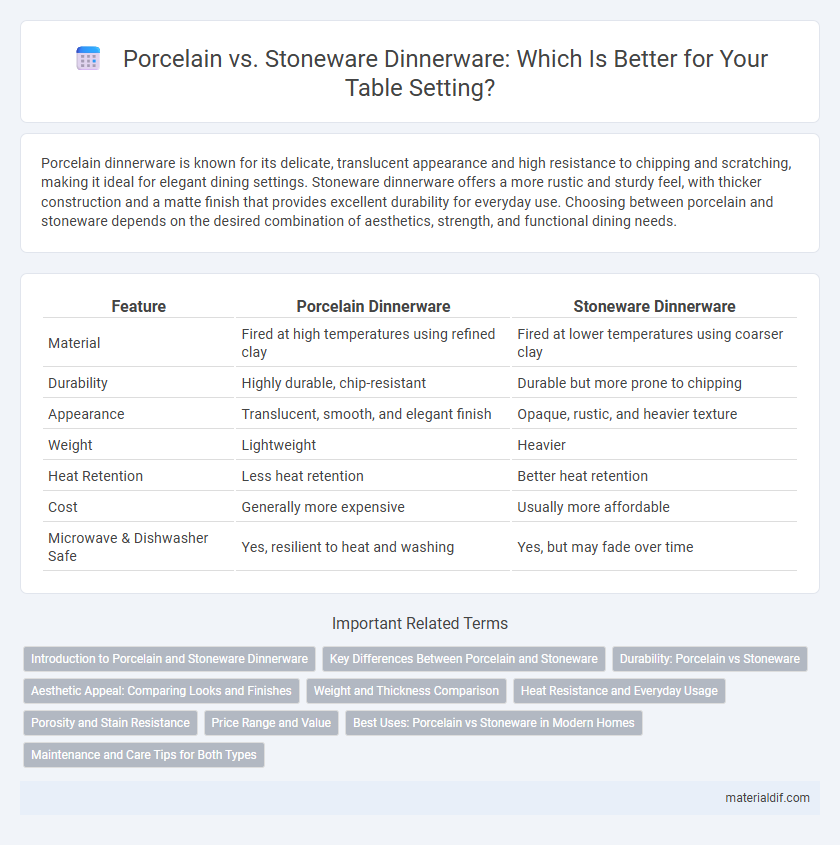Porcelain dinnerware is known for its delicate, translucent appearance and high resistance to chipping and scratching, making it ideal for elegant dining settings. Stoneware dinnerware offers a more rustic and sturdy feel, with thicker construction and a matte finish that provides excellent durability for everyday use. Choosing between porcelain and stoneware depends on the desired combination of aesthetics, strength, and functional dining needs.
Table of Comparison
| Feature | Porcelain Dinnerware | Stoneware Dinnerware |
|---|---|---|
| Material | Fired at high temperatures using refined clay | Fired at lower temperatures using coarser clay |
| Durability | Highly durable, chip-resistant | Durable but more prone to chipping |
| Appearance | Translucent, smooth, and elegant finish | Opaque, rustic, and heavier texture |
| Weight | Lightweight | Heavier |
| Heat Retention | Less heat retention | Better heat retention |
| Cost | Generally more expensive | Usually more affordable |
| Microwave & Dishwasher Safe | Yes, resilient to heat and washing | Yes, but may fade over time |
Introduction to Porcelain and Stoneware Dinnerware
Porcelain dinnerware is known for its delicate, translucent quality and high-fired, vitrified composition that makes it both strong and chip-resistant. Stoneware dinnerware, in contrast, is denser, thicker, and fired at lower temperatures, resulting in a more rustic, opaque appearance with excellent durability. Both materials offer unique benefits, with porcelain prized for its elegance and stoneware for its sturdy, casual appeal.
Key Differences Between Porcelain and Stoneware
Porcelain dinnerware is characterized by its high fired, vitrified, and translucent qualities, making it more delicate yet chip-resistant compared to stoneware, which is denser, opaque, and fired at lower temperatures resulting in a more durable and rustic appearance. Porcelain's fine, smooth texture and lighter weight differentiate it from stoneware's heavier and thicker composition, which enhances its resistance to chipping and temperature changes. Stoneware often features earthy tones and a more textured finish, whereas porcelain offers a glossy, refined look with superior resistance to staining and thermal shock in everyday use.
Durability: Porcelain vs Stoneware
Porcelain dinnerware offers superior durability with its high firing temperature and dense, non-porous structure, making it resistant to chipping, cracking, and thermal shock. Stoneware, while also durable, is generally thicker and less vitrified, which can lead to increased susceptibility to chipping and wear over time. The hardness and strength of porcelain make it more suitable for frequent use and dishwasher safety compared to stoneware dinnerware.
Aesthetic Appeal: Comparing Looks and Finishes
Porcelain dinnerware features a smooth, translucent finish with a refined, glossy surface that enhances its elegant and delicate appearance, making it a popular choice for formal dining settings. In contrast, stoneware dinnerware offers a more rustic, matte, and textured finish, emphasizing earthy tones and a handcrafted look that suits casual or farmhouse-style decor. The aesthetic appeal of porcelain lies in its sleek, polished look, while stoneware stands out with its robust, artisanal charm.
Weight and Thickness Comparison
Porcelain dinnerware is generally lighter and thinner than stoneware, offering a more delicate and refined feel suitable for formal settings. Stoneware is denser and thicker, providing greater durability and a rustic aesthetic ideal for everyday use. The weight difference influences handling comfort, with porcelain favored for its lightweight convenience and stoneware prized for its sturdy robustness.
Heat Resistance and Everyday Usage
Porcelain dinnerware exhibits superior heat resistance, enduring temperatures up to 482degF (250degC), making it ideal for microwave and oven use without cracking. Stoneware, while durable and chip-resistant, typically withstands heat only up to 392degF (200degC), limiting its suitability for high-temperature cooking or reheating. For everyday usage, porcelain offers a lightweight, non-porous surface that resists staining and absorbs less water, enhancing durability and hygiene compared to the denser, more porous stoneware.
Porosity and Stain Resistance
Porcelain dinnerware features a non-porous, vitrified surface that resists stains and prevents liquid absorption, making it highly durable and easy to clean. Stoneware, while dense, is more porous than porcelain, often requiring a glaze to enhance its stain resistance and prevent moisture penetration. The low porosity of porcelain contributes significantly to its superior stain resistance and long-lasting aesthetic appeal compared to stoneware.
Price Range and Value
Porcelain dinnerware typically falls into a higher price range than stoneware due to its refined, non-porous quality and durability, offering long-lasting value for formal settings. Stoneware, often more affordable and thicker, provides excellent value for everyday use with its sturdy construction and chip resistance. Both materials deliver distinct advantages in price-to-performance ratio, catering to different needs and budgets.
Best Uses: Porcelain vs Stoneware in Modern Homes
Porcelain dinnerware excels in modern homes for formal dining due to its elegant, translucent finish and superior chip resistance, making it ideal for special occasions and sophisticated table settings. Stoneware dinnerware offers durability and a rustic aesthetic, perfect for casual everyday use and family meals, as it withstands heavy handling and frequent dishwasher cycles. Both materials complement contemporary kitchens, with porcelain enhancing refined decor and stoneware providing a cozy, practical option for daily dining.
Maintenance and Care Tips for Both Types
Porcelain dinnerware requires gentle handling during washing to avoid chipping and is often dishwasher safe but should be placed securely to prevent damage. Stoneware dinnerware is more durable and resistant to chipping but can be prone to cracking under sudden temperature changes, so hand washing with mild detergent is recommended for longevity. Both porcelain and stoneware benefit from avoiding abrasive scrubbers and immediate drying to maintain their finish and prevent moisture stains.
Porcelain Dinnerware vs Stoneware Dinnerware Infographic

 materialdif.com
materialdif.com